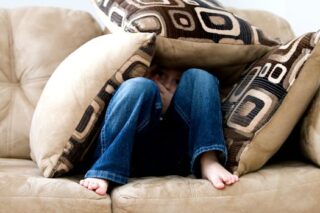
More Mental Health Articles
Overcoming the Fear of Darkness: Steps to Embrace Nighttime Comfort

The fear of dark, also known as nyctophobia, is a common condition that affects both children and adults. This anxiety disorder stems from the brain’s heightened perception of potential threats in the dark. By understanding the root causes and learning how to cope with this fear, individuals can learn to embrace nighttime with comfort and confidence.
Understanding the Fear of Dark
The fear of dark often begins in childhood and can persist into adulthood if not addressed. Factors leading to this fear include an overactive imagination, past traumatic experiences, and the brain’s instinct to anticipate dangers lurking in the shadows. While it is natural to have a heightened sense of awareness in the dark, excessive fear can impact daily life and sleep quality.
Recognizing Symptoms
Symptoms of fear of dark can include increased heart rate, sweating, trembling, and an intense urge to avoid darkness. Individuals may also experience difficulty sleeping or anxiety when thinking about nightfall. Identifying these symptoms is the first step toward effective management.
Strategies to Overcome the Fear of Dark
Several strategies can help mitigate the fear of dark. One effective method involves gradually increasing exposure to darkness in a controlled and safe environment. This technique is known as desensitization and can reduce the anxiety felt in dark settings.
Engaging in relaxation techniques, such as deep breathing exercises or meditation, can also help manage anxiety and promote a sense of calm before bedtime. Creating a comforting bedtime routine that includes soothing activities and a comfortable sleeping environment may aid in reducing nighttime anxiety.
Role of Support and Therapy
Support from friends, family, or a mental health professional can be beneficial in overcoming the fear of dark. Cognitive-behavioral therapy (CBT) is a structured approach that helps individuals identify and change negative thought patterns associated with their fear.
Consistency in attending therapy sessions and practicing learned coping mechanisms is key to gradually overcoming this phobia. It is important to remember that progress can be slow, and patience is essential.
Creating a Comforting Sleep Environment
The physical environment plays a significant role in how comfortable one feels during sleep. Consider these tips to make your sleeping area more inviting:
- Use soft lighting such as nightlights or dimmable lamps to provide a sense of security without disrupting melatonin production.
- Maintain a comfortable room temperature and invest in supportive bedding for optimal comfort.
- Incorporate calming scents like lavender or chamomile through essential oils or sprays to create a relaxing atmosphere.
By making these adjustments, individuals can create a sleep environment that reduces anxiety and promotes restful sleep.
When to Seek Professional Help
While many individuals can manage their fear of dark with self-help techniques, others may require professional intervention. If the fear significantly interferes with daily life or is accompanied by other health issues, it is crucial to seek guidance from a healthcare provider.
Professionals can offer tailored treatment plans and additional resources to address both the physical and psychological aspects of the phobia.
Additional Resources
Managing phobias like the fear of dark can often intertwine with other health challenges, such as addiction. For more information on related topics, read this article on understanding addiction.
For more general information on managing health-related fears, this Wikipedia article on health can provide additional insight.
- Fear of dark is common and can affect sleep quality and daily life.
- Exposure therapy, relaxation techniques, and creating a comforting sleep environment can aid in managing the fear.
- Support from loved ones or professionals can enhance coping strategies.
- Making environmental adjustments can lead to better sleep and reduced anxiety.
- Seeking help from healthcare providers is important if the fear significantly impacts life.
What is the fear of dark called?
Fear of dark is medically referred to as nyctophobia. It often stems from an amplified fear response to potential unseen threats.
At what age is fear of the dark most common?
The fear of dark is most commonly observed in children between 3 and 6 years old. However, it can persist into adulthood if it is not properly addressed.
How can I help a child who is afraid of the dark?
To help a child overcome their fear of dark, provide reassurance, establish a comforting bedtime routine, and ensure their sleep environment is conducive to relaxation. Gradual exposure to darkness may also help reduce anxiety.
Can fear of dark affect sleep quality?
Yes, fear of dark can significantly impact sleep quality by inducing anxiety that leads to difficulty falling asleep or staying asleep throughout the night.
When should someone seek professional help for fear of dark?
If the fear of dark is severe, persistent, and interferes with daily functioning or leads to frequent sleep disturbances, it is advisable to seek professional help. A clinician can provide personalized strategies and support.
Other Articles You May Find of Interest...
- Overcoming the Fear of Darkness: Steps to Embrace Nighttime Comfort
- Winning Under Pressure: Pro Golfers Reveal Their Mental Game Strategies
- Steps Anyone Can Take To Reduce Stress And Mental Fatigue
- Understanding ADHD and ADD: What’s the Difference and Are They the Same?
- Can Anxiety Lead to Daily Chest Pain?
- 7 Best Practices for Treating Your Anxiety
- The Truth Behind Pathological Liars: Understanding Their Behavior and Impact














